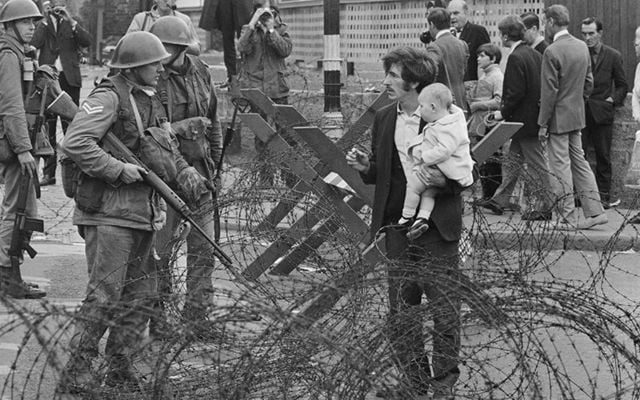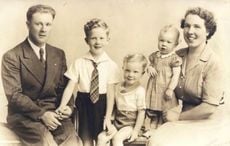In an extract from Who Was Responsible for the Troubles? Liam Kennedy examines who was behind the three decades of political violence in Northern Ireland from 1970 to the late 1990s.
Andrew Peden has been described as a “victim of the peace.” Less than a year after the signing of the Good Friday Agreement and five years after the loyalist and IRA paramilitary ceasefires of 1994, his home was invaded early one morning, he was abducted and taken to a flat in the Shankill in west Belfast, interrogated and beaten during the course of the day, and finally shot in the legs by the UDA (Ulster Defence Association), the largest of the loyalist paramilitary organizations. This was vigilante justice, Belfast-style.
The usual caliber of weapon used in such “punishment” attacks is a handgun. This time it was the more fearsome shotgun and only after the torture ordeal had gone on for twelve hours. The parting shot, as it were, was the blast to his legs from the shotgun.
Andrew Peden was taken to the Royal Victoria Hospital in Belfast. His left leg was amputated immediately – it felt like “raw steak” – and his right leg had to be taken off three months later. Both legs were amputated close to his groin. In addition to his own trauma and being condemned to life in a wheelchair, there was the transgenerational effect: “My two wee lads are growing up with so much anger.” There was one other detail: he was entirely innocent of the charge leveled against him, that of aiding a rival loyalist paramilitary group.
Read more
The self-image of loyalist volunteers in the UDA and the UVF (Ulster Volunteer Force) is that they were defending Northern Protestants. Similarly, the Provisional IRA prided itself as the line of defense against sectarian Protestant mobs and killers. The rhetoric on both sides is questionable.
Orange-on orange and green-on-green violence was an integral part of the three decades of political violence in Northern Ireland from 1970 to the late 1990s. It persists to this day, though on a reduced scale. Ironically, the worst period for paramilitary “punishments” was the years after the 1994 ceasefires and including the year of the Good Friday Agreement in 1998.
There is parity of disesteem as between loyalist and republican paramilitaries in the administration of “informal justice” or “rough justice” in the working-class areas they controlled. Of the more than 6,000 instances of “punishment” shootings and vigilante-style beatings recorded between 1973 and 2017, the spoils were roughly equally divided between loyalists and republicans.
But there is a deeper if counter-intuitive sense in which armed loyalists and republicans were questionable defenders of their respective communities. To take the Provisional IRA first: three Catholic civilians were murdered by loyalists between 1966 and the end of 1969, that is before the Provisional IRA became the ostentatious defenders of the Catholic and nationalist people. Three decades later, well over 500 Catholic civilians had been murdered by loyalist killers.
The story was much the same on the loyalist side. Armed republicans were responsible for more than 2,000 Troubles-related deaths, or six out of every ten killings. Hundreds of Protestant, and indeed Catholic civilians, died at the hands of the IRA. Remarkably, less than 2 percent of IRA killings, or twenty-eight to be precise, were of loyalist paramilitaries. Loyalist paramilitaries had little to fear directly from the IRA. The same was true the other way round.
So, the militarism of the UDA and the UVF induced murderous attacks on the Protestant and unionist community; the militarism of the IRA served to induce murderous attacks on Catholics and nationalists. The end result was that both sets of paramilitaries increased rather than reduced the vulnerability of their respective communities to politico-sectarian attack.
So, if both sets of paramilitaries were ineffective in defending their own communities (when not actually intimidating and maiming fellow loyalists or fellow nationalists), what communal role did they serve?
The answer is simple: What the IRA and loyalist paramilitaries could offer was the sweet odor of vengeance. And this is not to deny that each had wider political objectives within the triangular conflict that engulfed loyalists, republicans, and the British security forces.
Both sets of paramilitaries were pretty good at vengeance, as the tally of inter-communal killings testifies. Innocent-sounding place names like Monaghan, Kingsmill, Enniskillen, Teebane Cross, Poyntzpass, Greysteel, Loughinisland, Ormeau Road, Omagh are inscribed in the memories of the survivors of mass killings. Tombstones across the province bear cold witness.
The bombing of McGurk’s Bar on the corner of North Queen Street in Belfast in 1971 and the carnage at Frizzell’s fish shop (1993) on the nearby Shankill Road, almost a generation later, were prime expressions of communal sectarianism, albeit framed in terms of wider political motivations. These bookended a grim catalog of other multiple killings of civilians.
The unpalatable, unacknowledged truth on both sides of the paramilitary divide is that these organizations could only inflict vengeance on the other side, the odd exception notwithstanding. The same few examples of defensive operations, most notably the defense of St Matthew’s church in the Short Strand in east Belfast, June 1970, are retailed over and over again. This suggests the paucity of such cases.
As defenders – self-styled, self-deluded, or otherwise – paramilitaries proved not only ineffectual but counterproductive in terms of communal defense. Each invited vengeance killings from the other side and thus unionist and nationalist working-class neighborhoods were trapped in cycles of mutually assured terror.
This was on top of the intra-community violence of the kind encapsulated in extreme form in the case of Andrew Peden. His personal testimony brings us back to the terror within – a facet of the Troubles much neglected in conventional accounts.
“They beat me with poles. They said they were going to fill the bath [for torture by half-drowning]. They made me write a last letter to my kids. My hands were tied, but I managed to lift the blindfold and saw the window. I ran for it but bounced off. I never prayed as hard. I was drifting in and out. They finally took me outside. They shouted ‘Lie down. Lie down’. There was a bang and that’s the last thing I remember.”
* Liam Kennedy is Emeritus Professor Queens Unversity Belfast. Extracted from Who Was Responsible for the Troubles? The Northern Ireland Conflict (McGill-Queen’s University Press, Montreal, $35 Can.)

Love Irish history? Share your favorite stories with other history buffs in the IrishCentral History Facebook group.




Comments